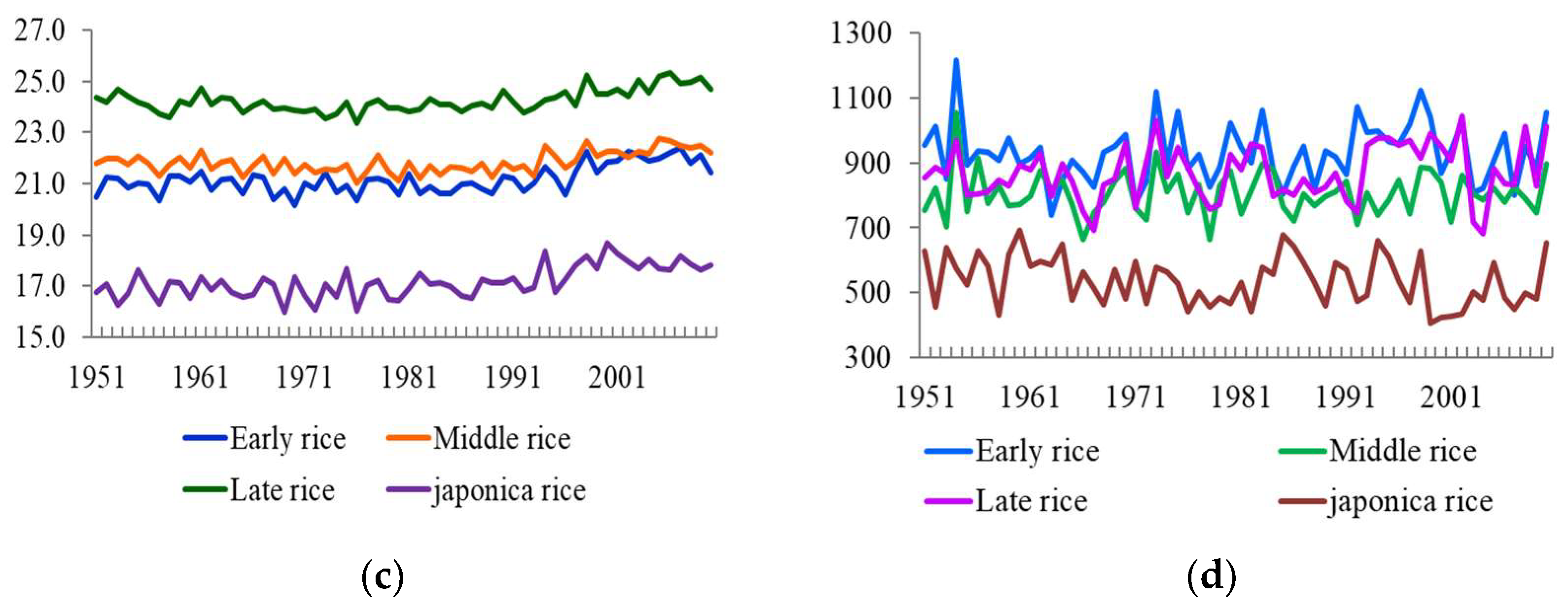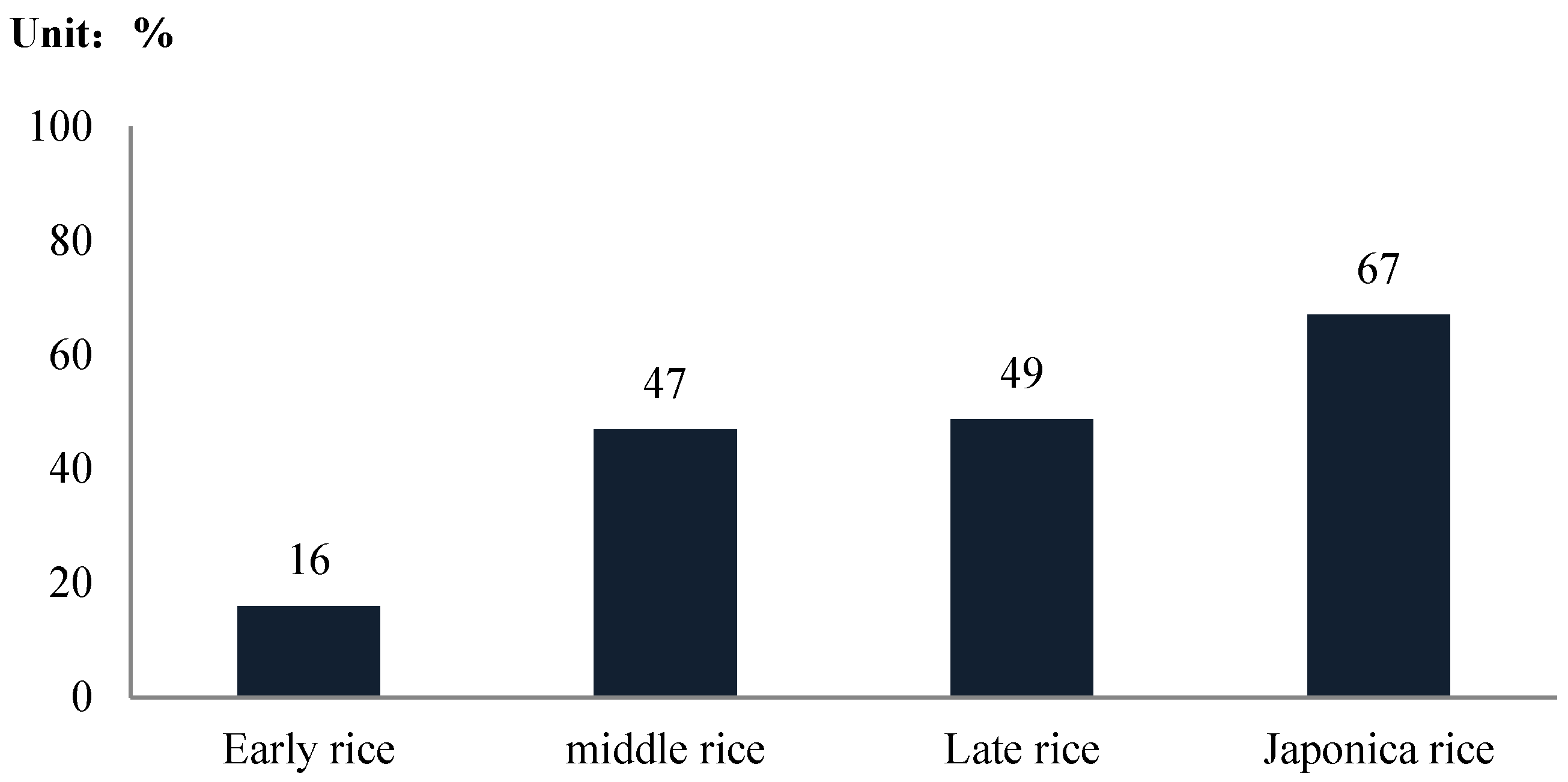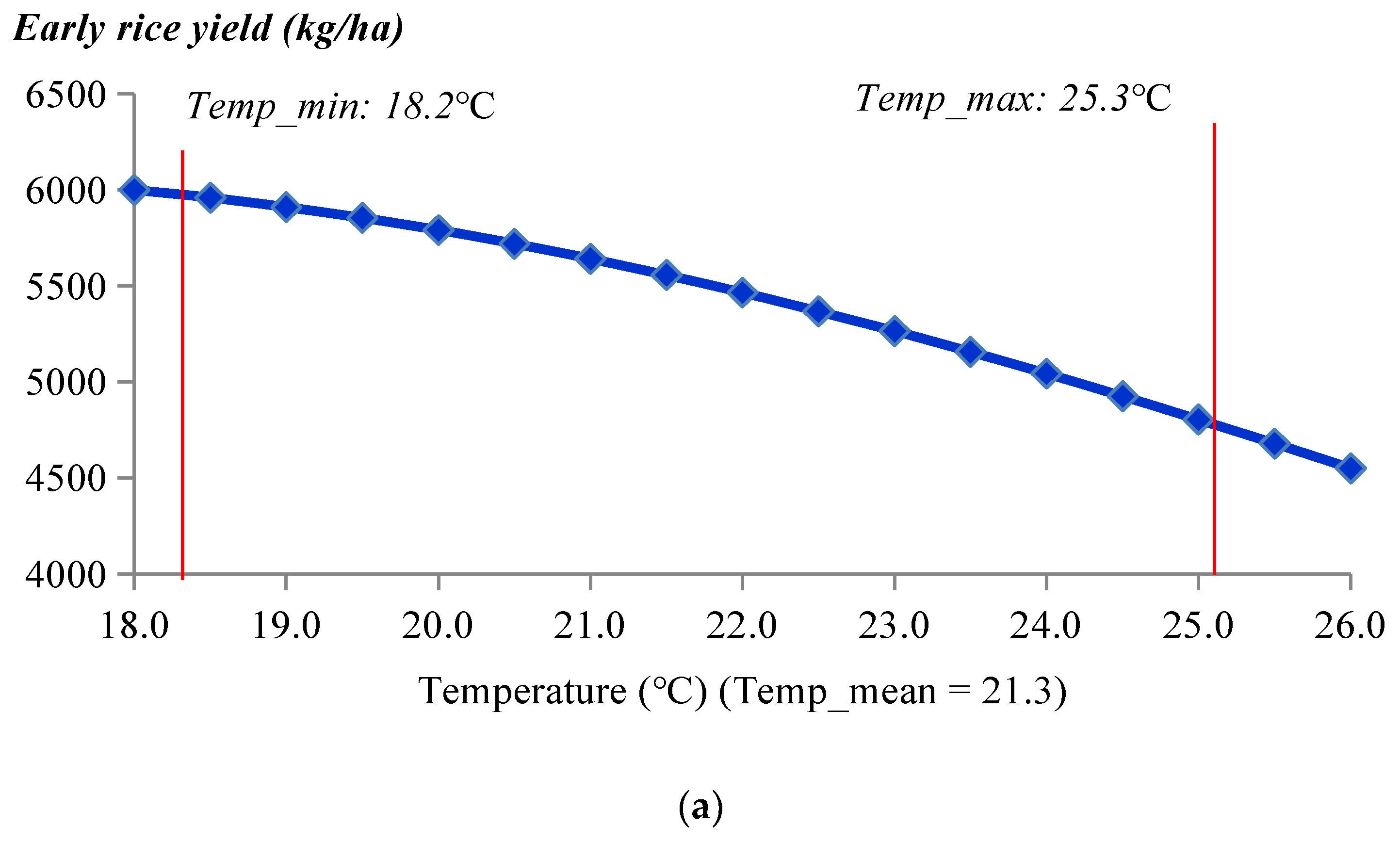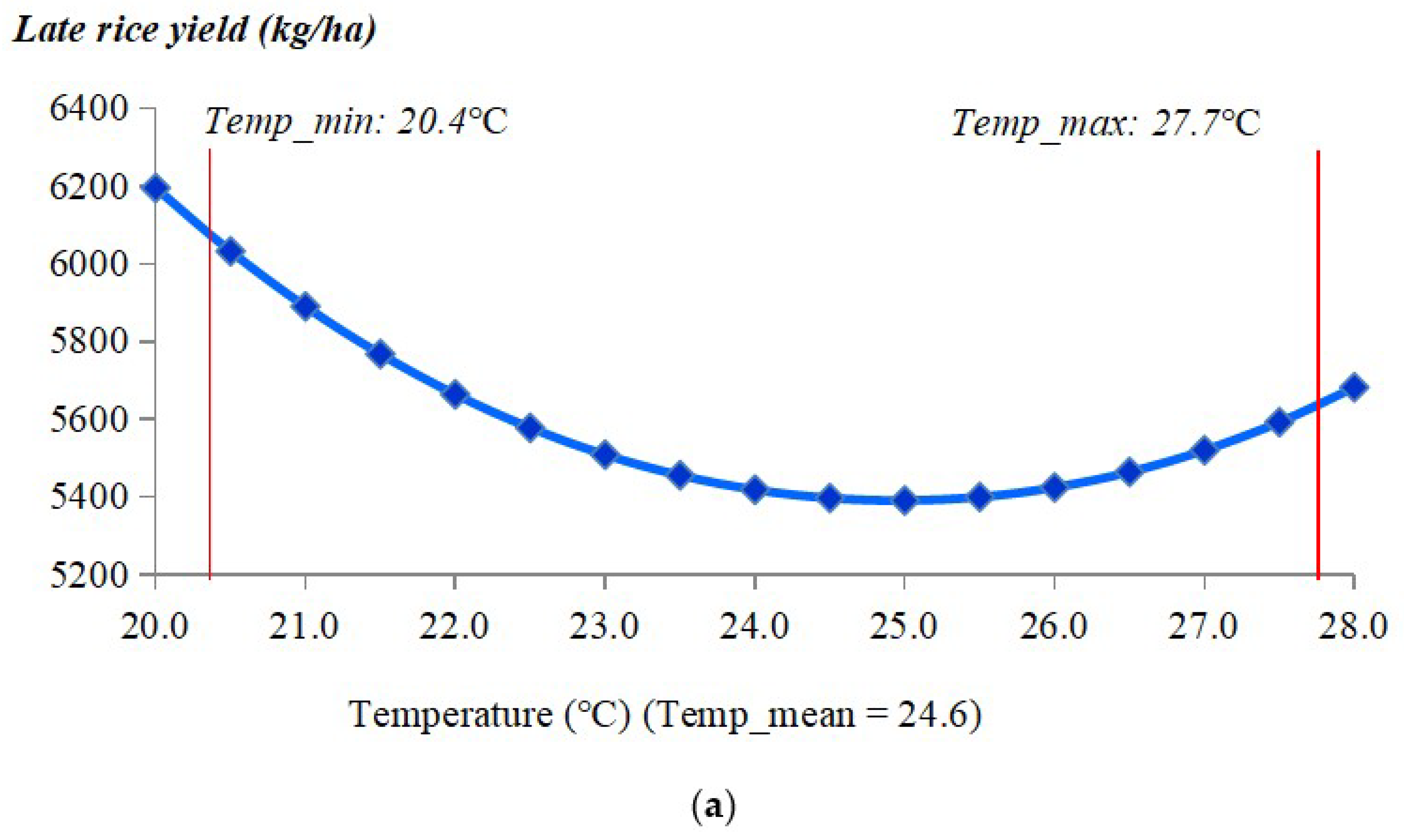1. Introduction
Rice plays an important role in China’s food security and agricultural production. Rice accounts for 9% of global crop production, and China produces more than 25% of the world’s output of rice [
1]. Rice is always one of the most important food crop in China, irrespective of the cultivated area or the total output. During the period 1978–2021, the average planting area of rice in China was about 30.98 million hm
2, accounting for 27.63% of the sown area of grain crops. Meanwhile, the average total output of rice in China was 0.19 billion tons, accounting for 37.67% of the total grain production in China (data source: National Bureau of Statistics of China,
https://data.stats.gov.cn/easyquery.htm?cn=C01, accessed on 10 October 2022). Rice is not only the most important food crop in China and the world, but also plays an important role in the global carbon cycle [
2].
However, a decrease in the proportion of rice’s sown area has been observed over the past 14 years in China, from 27.33% in 2007 to 25.44% in 2021. The sown area of corn began to surpass that of rice in 2007, and rice’s sown area dropped to the second largest among crops in China. The total rice output also moved to second place in 2012. The sustainable increase in total rice production is challenged by several trends and constrained by many factors in China [
3,
4]. Rice production is facing challenges from declining arable land, increasing water scarcity, global climate change, labor shortages, increasing consumer demand for high-quality rice, and other factors that limit the capacity of farmers to grow this crop [
3,
4,
5,
6,
7,
8,
9].
The impact of climate change on major crops such as corn, wheat, and rice has received increasing attention [
10,
11]. Extensive studies have used crop models and several climate change scenarios to simulate the impact of climate change on rice production [
5,
12,
13,
14,
15,
16,
17,
18]. The conclusions are inconsistent due to differences in crops, regions, RCPs, timeframes, adaptation, and CO
2 fertilization effects [
11]. Climate change has caused regionally different—but mostly negative—impacts on rice yields [
9,
19,
20,
21,
22,
23,
24,
25,
26]. Globally, warming trends from 1961 to 2017 had a negative effect of 4.2% on rice yield [
9]. Even considering CO
2 fertilization effects, an overall median per-decade effect of −0.7% for rice yields was projected without adaptation in the 21st century [
21]. A 1.8% loss in rice yield has been reported due to global changes in precipitation between 1981 and 2010 [
22]. The overall drought-driven loss of rice yield is projected to increase by 18.1% to 19.4% in the period of 2071–2100, relative to 1961–2016 (RCP8.5) [
23]. Regionally, negative effects of climate change have been identified for rice in North Africa, sub-Saharan Africa, Western Asia, South Asia, Southeast Asia, and North America, while the effects are positive in Australia and New Zealand [
21]. New research findings affirm that the impacts of climate change will continue to significantly affect rice production, mainly in a negative direction, in particular areas all over Asia [
24].
The results on the effects of climate change on rice yields in China are quite mixed, being dependent on regional scale, analysis approaches, the time period, the assumption of the CO
2 fertilization effect, the climate change scenarios, and whether considering adaptation and socioeconomic scenarios [
17,
18,
19,
27,
28]. Based on the data of 30 Chinese provinces spanning 1998–2017, it was found that rice cultivation will decline by 0.66% if the mean temperature increases by 1% in the long term, but the average temperature in the short term is conducive to China’s rice production [
18]. Rice yields will decrease by 5–25% after the 2060s due to climate change [
27], but the average yields of both early rice and late rice will increase during the 2050s and 2070s compared to the 2000s [
19]. Using data between 1980 and 2010 in Northeast China, a study has provided evidence that a 1% increase in the rice’s accumulated temperature significantly increases rice production by approximately 0.728% [
28]. Most researchers believe that increased rainfall is beneficial to rice production in China. For example, a recent study found that in the long term, a 10% rise in mean rainfall would increase rice cultivation by 0.46% in China [
18].
Despite the wide variety of findings that have arisen regarding the effects of climate change on crop yields [
9,
10,
17,
29,
30], there are many limitations to the previous studies. Firstly, a majority of climate impact studies concern changes in the means of climate variables, while fewer studies consider climate variability and extreme events [
30]. Second, previous studies have analyzed the effects of changes in climatic variables on the mean crop yields, while the impacts of climate change on fluctuations in crop yields have been studied to a much lesser extent [
29,
30,
31]. Thirdly, existing studies on the impacts of climate change on crop yields focus on crop modeling or statistical analysis based on historical data [
17,
29,
31]. One of the major shortcomings of these two methodologies is that factors other than climate—such as technological progress and production inputs—are not controlled [
29]. Fourthly, there is much uncertainty in simulating the impacts of future climate change on crop yields based on coarse-resolution climate change scenarios from global climate models (GCMs) or scenarios assuming fixed increases in mean temperature or precipitation [
13,
32,
33]. Fifthly, there are relatively few direct assessments of the impact of observed climate on past crop yields and growth employing econometric models to control for both the traditional factors and climate change—especially with respect to studies in China. Furthermore, the existing studies on rice in China are based on data aggregated over different types of rice; thus, little is known about the effects of climate change among varieties of rice. However, there are two main rice varieties according to the geographic distribution of rice production in China: indica rice and japonica rice. Indica rice can be further divided into early rice, middle rice, and late rice. Due to differences in growing regions, growing seasons, and variety characteristics, the effects of climate change on rice yields might vary between different types. Few researchers have analyzed the differences in responses to climate change between early and late rice [
7,
19], and there is no literature concerning the impacts of climate change on japonica and indica rice in China.
In order to address the limitations of existing studies, a great deal of interest exists in answering the following questions: What is the historical evidence on the impacts of climate change on rice yields in China after controlling for the influence of other factors? Specifically, what are the impacts of climate change (mean and variability) on the mean and the variance of indica (early, middle, and late rice) and japonica rice? The overall goal of this study was to examine the impacts of climate change and its variation on both the mean and the variance of rice yields in China. To achieve this goal, we set the following three specific objectives: The first was to gain a better understanding of the changes in climate over the past several decades in China and in the sample areas, as well as the changes in rice yields over the past 30 years. The second objective was to conduct an econometric analysis to identify the impacts of climate change and its variation on the mean and the variance of rice yields in China. The third objective was to quantify the contribution of climate change and its variation to the growth of rice yields in China. The final objective was to predict the possible effects of climate change on rice yields among different regions and different types in the future.
Given the limited empirical studies on the effects of climate change on rice yields, this study contributes to the literature in several ways: First, an econometric model is developed to determine the impacts of climatic variables on rice yields, so as well as climate variability, technological progress and production inputs are controlled in the empirical analysis. Second, in addition to the changes in the means of climate variables, the climate variability is also considered in this study. Third, this study not only examines the impacts of climatic factors on mean rice yields, but also investigates how climate factors affect the variability of rice yields. Finally, indica rice and japonica rice are separately analyzed to explore the different effects of climate change between various rice types.
The rest of this paper is organized as follows: In the next section, we briefly introduce the data used in this study and describe the changes in climate (i.e., temperature and precipitation) and rice yields in the sample area.
Section 3 introduces the research methodology and the specification of the econometric models.
Section 4 presents the econometric results on the impacts of climate change and its variability on rice yields, further discusses the contribution rates of climate and other factors to changes in rice yields, and predicts the future effects of climate change on rice yields in different regions and rice varieties. The final section concludes the paper.
5. Conclusions and Policy Implications
This study used an econometric model to estimate Just–Pope stochastic production functions and identify the potential impacts of temperature and precipitation on the mean and variance of rice yields by rice type (indica rice and japonica rice). Based on the estimated production functions, the contribution rate of climatic factors to rice yields was then assessed by conducting the growth accounting of yields over the past 30 years. Finally, the relationship between the changes in the temperature and precipitation and the mean rice yields was further explored by region.
Based on the historical climate and rice yield data, the estimation results from the econometric models show that not only the mean rice yield, but also the yield variance, will be influenced by climate change. Moreover, not only the mean trend change of climate change, but also the climate variance, will significantly influence rice yields. This study also finds that the impacts of climate change on rice yield differ by rice type and by region.
In the past 30 years, rising temperatures have reduced the mean yield of indica rice, while they have contributed to the yield growth of japonica rice. Precipitation has a positive effect on the yield growth of early rice, while it has negative effects on the yield growth of middle rice, late rice, and japonica rice. The larger standard deviation of temperature over the growing season had a positive contribution to the yield growth of early rice and japonica rice, while it had a negative contribution to the yield growth of middle rice and late rice. The larger standard deviation of precipitation negatively influenced the mean yields of middle rice, late rice, and japonica rice, but it had a positive effect on the yield growth of early rice.
In the future, the impacts of climate change on rice yield will depend on local regions’ present climate condition. The rise in temperature and increased precipitation over the early rice growing season will have negative impacts on the mean yields for all study regions. Higher temperatures over the middle rice growing season will reduce the yield of middle rice before the temperature rises to 28.3 °C in the study regions. However, increased precipitation will increase the mean yield of middle rice in some regions and reduce it in other regions. For late rice and japonica rice, higher temperatures will have a positive effect on the mean yield in some regions, while having a negative effect in other regions. Increased precipitation will reduce the mean yields of late rice and japonica rice for all of the study regions. Therefore, improving the adaptation capacity of rice production requires full consideration of rice types and regional differences.
















